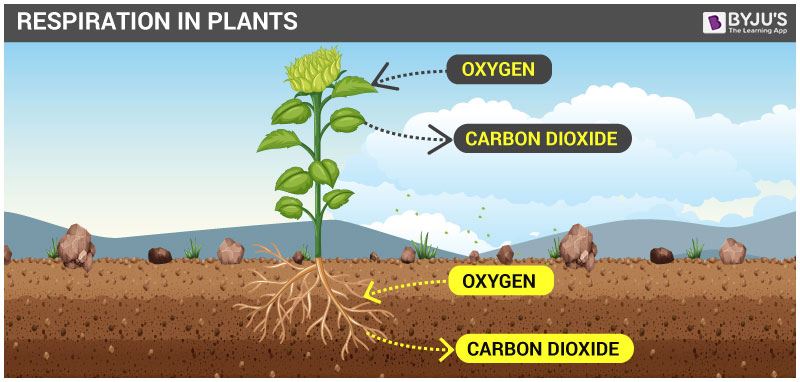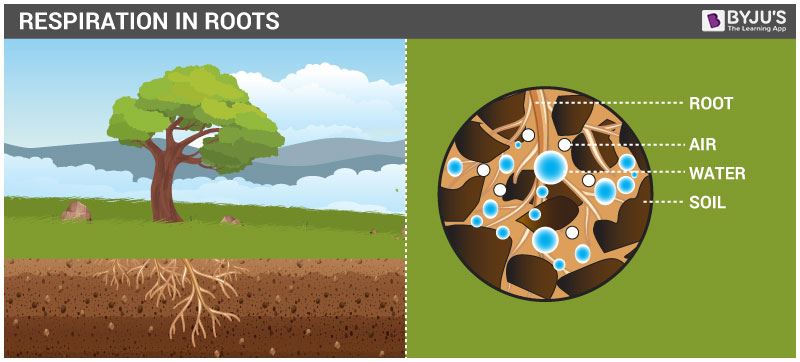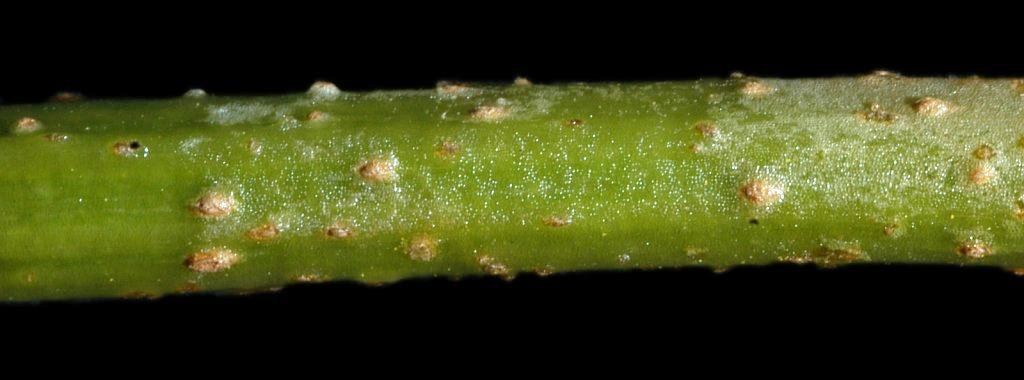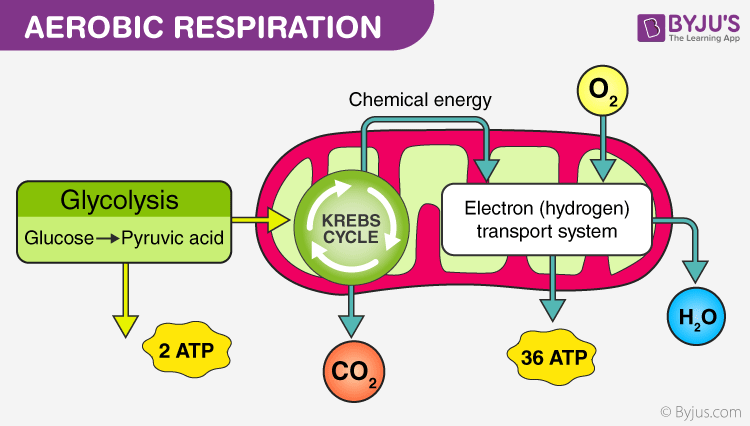Respiration is a chain of chemical reactions that enables all living entities to synthesize energy required to sustain.
It is a biochemical process wherein air moves between the external environment and the tissues and cells of the species. In respiration, inhalation of oxygen and exhalation of carbon dioxide gas takes place. As an entity acquires energy through oxidising nutrients and hence liberating wastes, it is referred to as a metabolic process.
Also refer: Respiration – A Life Process
Let us have a look at the respiration in plants notes provided here to know about the process of respiration, and the different types of respiration that occur in plants.
Do Plants Breathe?
Yes, like animals and humans, plants also breathe.
Plants do require oxygen to respire, the process in return gives out carbon dioxide. Unlike humans and animals, plants do not possess any specialized structures for exchange of gases, however, they do possess stomata (found in leaves) and lenticels (found in stems) actively involved in the gaseous exchange. Leaves, stems and plant roots respire at a low pace compared to humans and animals.
Breathing is different from respiration. Both animals and humans breathe, which is a step involved in respiration. Plants take part in respiration all through their life as the plant cell needs the energy to survive, however, plants breathe differently, through a process known as Cellular respiration.
In this process of cellular respiration, plants generate glucose molecules through photosynthesis by capturing energy from sunlight and converting it into glucose. Several live experiments demonstrate the breathing of plants. All plants respire to provide energy for their cells to be active or alive.
Let us take a look at the respiratory process in plants.
The Process of Respiration in Plants
During respiration, in different plant parts, significantly less exchange of gas takes place. Hence, each part nourishes and fulfils its own energy requirements.
Consequently, leaves, stems and roots of plants separately exchange gases. Leaves possess stomata – tiny pores, for gaseous exchange. The oxygen consumed via stomata is used up by cells in the leaves to disintegrate glucose into water and carbon dioxide.

Respiration In Roots
Roots, the underground part of the plants, absorbs air from the air gaps/spaces found between the soil particles. Hence, absorbed oxygen through roots is utilized to liberate the energy that in the future, is used to transport salts and minerals from the soil.

We know that plants possess a specific ability to synthesize their own food through photosynthesis. Photosynthesis takes place in only those parts of the plants which have chlorophyll, the green plant parts. Photosynthesis is so evident that at times it seems to mask the respiratory process in plants. Respiration must not be mistaken for photosynthesis. Respiration occurs all through the day, but the photosynthesis process occurs in the daytime, in the presence of sunlight only. Consequently, respiration becomes evident at night time in plants.
This is the reason we often hear people warn against sleeping under a tree during nighttime, as it may lead to suffocation due to excess amounts of carbon dioxide liberated by trees following respiration.
Respiration In Stems

The air in case of stem diffuses into the stomata and moves through different parts of the cell to respire. During this stage, the carbon dioxide liberated is also diffused through the stomata. Lenticels are known to perform gaseous exchange in woody or higher plants.
Respiration In Leaves

Leaves consist of tiny pores known as stomata. Gaseous exchange occurs through diffusion via stomata. Guard cells regulate each of the stomata. Exchange of gases occurs with the closing and opening of the stoma between the inferior of leaves and the atmosphere.
Differences between Respiration and Photosynthesis
| Photosynthesis | Respiration |
| This process is common to all green plants containing chlorophyll pigments. | This process is common to all living things, including plants, animals, birds, etc. |
| Food is synthesized. | Food is oxidised. |
| Energy is stored. | Energy is released. |
| Is an anabolic process. | Is a catabolic process. |
| Cytochrome is required. | Cytochrome is required here too |
| It is an Endothermal process. | It is an Exothermal process. |
| It comprises products such as water, oxygen and sugar | It comprises products such as carbon dioxide and hydrogen |
| Radiant energy is converted into potential energy. | Potential energy is converted into kinetic energy. |
| Occurs during daytime in the presence of sunlight only. | Is a continuous process, taking place all through the lifetime |
Also, refer to the Difference Between Photosynthesis and Cellular Respiration
Types of Respiration
There are two main types of respiration.

Aerobic Respiration
This type of respiration takes place in the mitochondria of all eukaryotic entities. Food molecules are completely oxidised into the carbon dioxide, water, and energy is released in the presence of oxygen. This type of respiration is observed in all the higher organisms and necessitates atmospheric oxygen.
Anaerobic Respiration
This type of respiration occurs within the cytoplasm of prokaryotic entities such as yeast and bacteria. Here, lesser energy is liberated as a result of incomplete oxidation of food in the absence of oxygen. Ethyl alcohol and carbon dioxide are produced during anaerobic respiration.
Also, refer to Respiration and its Types
Stay tuned with BYJU’S to learn more about Respiration in Plants and other related topics at BYJU’S Biology.
Recommended Video:

Important Questions for you
- How do plants breathe?
All green plants breathe through the process of Cellular respiration. In this process, nutrients obtained from the soil are converted into energy and are used for different cellular activities.
- Do plants breathe at night?
Yes, plants breathe throughout its life span both during the day and night. The chemical equation of cellular respiration is expressed as — oxygen + glucose -> carbon dioxide + water + heat energy.
- Name the respiratory organ in woody stems.
In hard and woody stems, respiration or the exchange of gases takes place through lenticels. They are the small pores, scattered all over the bark and are found in all trees.
- What is the role of stomata in plant’s respiration?
Stomata are the tiny pores located on the epidermis of leaves, stems and other organs. During cellular respiration, stomata facilitate gaseous exchange by opening and closing of the pores.
- Which part of roots is involved in the exchange of respiratory gases?
Root hairs, the tubular extensions of the epidermis are involved in the exchange of respiratory gases.
Register at BYJU’S for more on respiration in plants notes for reference.

I really appriciate your service for bein supportive in my research, thanks very much.
This is very useful thankss
i really like the way of explanation.
It is very helpful 👍😊 I really like the way byjus explain the content good job…
Yaa! Actually very satisfying
Thank you very much I need this for my learning
Thank u so much. It was very helpful for me in studying.
kindly till me the specific definition of plant cellular respiration ?
Nice
Thanks for writing this!
Thanks too much
I love this learning process thanks a lot ❤️❤️❤️
I love learning this process